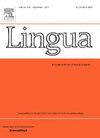成人语前失聪的普通话引文声调感知
IF 1.3
3区 文学
0 LANGUAGE & LINGUISTICS
引用次数: 0
摘要
目的研究人工耳蜗(CIs)或助听器(HAs)的语前聋成人(pda)对普通话引文声调的感知。考察了音韵复杂程度和助听器类型对声调识别的影响。74名说普通话的参与者(30名听力正常的人,18名CI使用者和26名HA使用者)完成了四种强制选择音调识别任务。刺激包括具有不同韵律复杂性的单音节(简单、开放、鼻音)和音调对(六对音调)。鼠标跟踪用于捕捉反应轨迹和时间。结果在所有情况下,正常听力组的识别准确率均高于聋人组。音调对T2-T3和T2-T4对CI和HA用户尤其具有挑战性。押韵复杂性只影响聋哑人,鼻音押韵表现最差。虽然CI使用者的听力损失较严重,但他们的表现与HA使用者相似。结论声调类型和韵律复杂性对掌上电脑普通话声调感知的影响,提示需要进行设备特异性听觉训练。本文章由计算机程序翻译,如有差异,请以英文原文为准。
Mandarin citation tone perception in prelingually deaf adults
Objective
This study investigated how prelingually deaf adults (PDAs) with cochlear implants (CIs) or hearing aids (HAs) perceive Mandarin citation tones. The effects of rhyme complexity and hearing device type on tone identification were examined.
Design
Seventy-four Mandarin-speaking participants (30 normal-hearing, 18 CI users, and 26 HA users) completed a four-alternative forced-choice tone identification task. The stimuli included monosyllables with different rhyme complexities (simple, open, nasal) and tone pairings (six tone pairs). Mouse-tracking was used to capture response trajectories and timing.
Results
Normal-hearing participants showed higher accuracy than both deaf groups in all conditions. Tone pairs T2–T3 and T2–T4 were particularly challenging for CI and HA users. Rhyme complexity influenced only the deaf groups, and nasal rhymes showed the worst performance. Although CI users had more severe hearing loss, their performance was similar to that of HA users.
Conclusions
These results highlight the impact of tone types and rhyme complexity on Mandarin tone perception in PDAs and suggest the need for device-specific auditory training.
求助全文
通过发布文献求助,成功后即可免费获取论文全文。
去求助
来源期刊

Lingua
Multiple-
CiteScore
2.50
自引率
9.10%
发文量
93
审稿时长
24 weeks
期刊介绍:
Lingua publishes papers of any length, if justified, as well as review articles surveying developments in the various fields of linguistics, and occasional discussions. A considerable number of pages in each issue are devoted to critical book reviews. Lingua also publishes Lingua Franca articles consisting of provocative exchanges expressing strong opinions on central topics in linguistics; The Decade In articles which are educational articles offering the nonspecialist linguist an overview of a given area of study; and Taking up the Gauntlet special issues composed of a set number of papers examining one set of data and exploring whose theory offers the most insight with a minimal set of assumptions and a maximum of arguments.
 求助内容:
求助内容: 应助结果提醒方式:
应助结果提醒方式:


